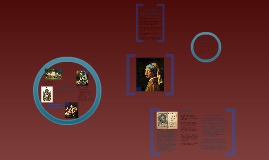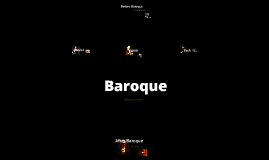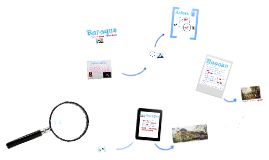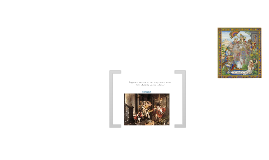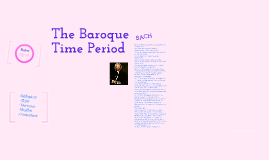Baroque
Transcript: Things to Look for in Baroque Art: Images are direct, and dramatic. Depictions feel physically and psychologically real. Emotionally intense. Extravagant settings and ornamentation. Dramatic use of color. Dramatic contrasts between light and dark, light and shadow. Baroque art has continuous overlapping of figures and elements. Common themes: grandiose visions, ecstasies and conversions, martyrdom and death, intense light, intense psychological moments. The "psychological pain of man" is often found to be in both art and architecture Baroque architecture is characterized by large, magnificent buildings, typically asymmetrical and flowing. The oval was usually employed. To Apollo chasing Daphne Ruddy silversmith from up on high, in whose bright beams the rabble pick their fleas: Daphne, that nymph, who takes off and won't speak, if you'd possess her, pay, and douse your light. If you want to save yourself the pain, oh, eye of heaven, try to buy her love: Mars for bonbons sold his coat of mail, and then his sword for jugs and sweet delights. Stodgy Jupiter became a purse; the maiden raised her skirt above her knees in showers of coins to catch him on the run. That was the doing of some duenna star, --a star without a duenna it can't be-- Phoebus, get her help, since you're the sun. Judith Slaying Holofernes by Artemisia Gentileschi The Ecstasy of St. Teresa by Gian Lorenzo Bernini Of Mans First Disobedience, and the Fruit of that Forbidden Tree, whose mortal tast brought Death into the World, and all our woe, with loss of Eden, till one greater Man restore us, and regain the blissful Seat, sing Heav'nly Muse, that on the secret top Of Oreb, or of Sinai, didst inspire That Shepherd, who first taught the chosen Seed, in the Beginning how the Heav'ns and Earth rose out of Chaos... Key Historical Events -Art & Architecture- Ludwigsburg Palace in Germany Literature Baroque literally means irregular. Baroque stylying became most popular after the counter-reformation, when Europe underwent a strong relitious change. Baroque style became popular in royal courts because it symbolized the power of the new monarchies. Baroque painting originated in Italy and spread north. The term Baroque also refers to a period of music that was during a slightly later time. THE BAROQUE ERA 1602 - Establishment of the Dutch East India Company: a very profitable company involved with the trading of spices . Lasted well into the 18th century. 1618-1648 - The Thirty Years War: a lenghty war that involved most of the countries in Europe at one point. This also marked the end of the Counter-Reformation. 1642 - Death of Galileo Galilei: accused of being a heratic for suggesting the idea of a heliocentric (sun centered) universe, he became a prisoner in his own home 1643-1715 - Reign of Louis XIV (the Sun King): he ruled for 72 years, starting at the age of four. "If it's not Baroque, don't fix it" Cogsworth Girl With a Pearl Earring by Jan Vermeer (1600-1750) The main purpose of Baroque literature was to move the reader with the strong emotions presented in the writing. Most of the works had religious themes (as exampled on the left, in "Paradise Lost" by John Milton. Metaphors were often used in Baroque literature, so much so the era became known for it in later decades. The Spanish became well known for their Baroque literature, with authors such as Francisco de Quevedo, who wrote "To Apollo chasing Daphne" on the right. Mythological references were often made in Baroque literature.






